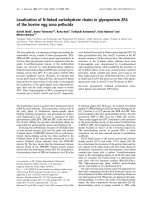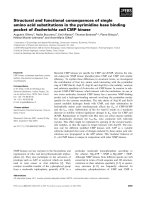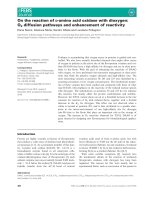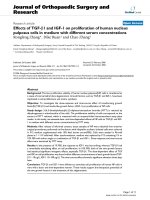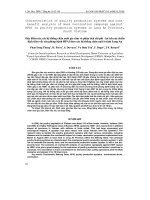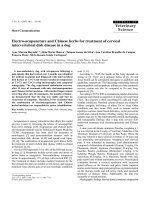Palladium-catalyzed ligand-free and efficient Suzuki–Miyaura reaction of N -methyliminodiacetic acid boronates in water
Bạn đang xem bản rút gọn của tài liệu. Xem và tải ngay bản đầy đủ của tài liệu tại đây (307.34 KB, 8 trang )
Turk J Chem
(2015) 39: 1208 1215
ă ITAK
c TUB
Turkish Journal of Chemistry
/>
doi:10.3906/kim-1505-97
Research Article
Palladium-catalyzed ligand-free and efficient Suzuki–Miyaura reaction of
N -methyliminodiacetic acid boronates in water
Chun LIU∗, Xinmin LI, Xinnan WANG, Jieshan QIU
State Key Laboratory of Fine Chemicals, Dalian University of Technology, Dalian, P.R. China
Received: 26.05.2015
•
Accepted/Published Online: 26.07.2015
•
Printed: 25.12.2015
Abstract: A green and efficient protocol has been developed for the Pd(OAc) 2 -catalyzed ligand-free Suzuki–Miyaura
reaction of N -methyliminodiacetic acid (MIDA) boronates in water. In the presence of Pd(OAc) 2 as a catalyst and
( i -Pr) 2 NH as a base, the cross-coupling reactions of aryl bromides with aryl MIDA boronates proceeded smoothly in
water without any surfactant, and various functional groups were tolerated under the optimized conditions.
Key words: Palladium, ligand-free, Suzuki–Miyaura reaction, N -methyliminodiacetic acid boronates, water
1. Introduction
The palladium-catalyzed Suzuki–Miyaura cross-coupling reaction has been considered as one of the most powerful and popular tools for preparation of biaryl compounds, which are important structural moieties in natural
products and pharmaceutical and functional materials. 1−5 Arylboronic acids are the most common nucleophilic
reagents for the Suzuki–Miyaura reaction. 6,7 However, superstoichiometric loadings (1.5–2.0 eq.) of arylboronic
acids are often required in aqueous Suzuki–Miyaura cross-coupling catalytic systems due to the undesired side
reactions of homocoupling 8,9 and protodeboronation. 10,11 In addition, some of the organoboronic acids, such as
2-heteroarylboronic acids, are unstable, which limits their application in cross-coupling reactions. 12−14 Since the
first report in the early 1980s, the N -methyliminodiacetic acid (MIDA) boronates have emerged as an attractive
and promising alternative to organoboronic acids in cross-coupling reactions. 15,16 The MIDA boronates are nontoxic, biodegradable, and crystalline solids that are stable for storage indefinitely on the benchtop in air without
decomposition. 17 These bench-stable boronates can be easily prepared from corresponding organoboronic acids,
and many MIDA boronates are currently commercially available. 17,18 In recent years, Suzuki–Miyaura systems
involving MIDA boronates have been developed by the research groups of Burke, 13,17,19−21 Wu, 22 Yudin, 23
and many others. Among these systems, ligands including phosphines and carbenes were used for promoting
the cross-coupling reaction. However, compared with the ligand-promoted Suzuki–Miyaura reaction systems,
only a few ligand-free protocols are reported for the Suzuki–Miyaura reaction of MIDA boronates. 24 In 2014,
da Silva et al. 25 reported a phosphine-free Suzuki–Miyaura cross-coupling system for aryl or (2-pyridyl) MIDA
boronates in aqueous ethanol using polyurea microencapsulated palladium (Pd EnCat30) as the catalyst. Very
recently, we reported the palladium-catalyzed ligand-free cross-couplings of heteroaryl halides with aryl MIDA
boronates. 26 In the present paper, we report a simple and efficient catalytic system for the Suzuki–Miyaura
∗ Correspondence:
1208
LIU et al./Turk J Chem
reaction of aryl MIDA boronates with aryl halides in pure water without any additive. This catalytic system,
using Pd(OAc) 2 as the catalyst and ( i -Pr) 2 NH as the base, is highly efficient for a broad range of substrates.
2. Results and discussion
Initially, the effects of various bases on the cross-coupling reaction were investigated. The cross-coupling of
4-bromonitrobenzene with phenylboronic acid MIDA ester was chosen as a model reaction. As shown in Table
1, the most efficient base in the present catalytic system was diisopropylamine, which provided a 94% yield in
4 h (Table 1, entry 1). The other bases, such as Et 3 N, K 2 CO 3 , Cs 2 CO 3 , K 3 PO 4 ·3H 2 O, and KOH (Table
1, entries 2–6), gave disappointing results. Thus, we chose diisopropylamine as the base for further study.
Recently, we found that the cross-coupling reactions of aryl halides with arylboronic acids could be performed
with good yields in pure water. 27 To compare the reactivity of the organoboron reagents in this system, the
cross-coupling reaction of 4-bromonitrobenzene with phenylboronic acid or phenylboronic acid pinacol cyclic
ester was carried out and a 93% or 62% yield was obtained in 4 h under air, respectively (Table 1, entries 7 and
8). It is obvious that both phenylboronic acid and the phenylboronic acid MIDA ester are very active, while
the phenylboronic acid pinacol cyclic ester is less active.
Table 1. The effect of base on the Suzuki–Miyaura reaction. a
Entry
1
2
3
4
5
6
7
8
a
Reaction conditions: 4-bromonitrobenzene (0.5 mmol), arylboronic acid MIDA ester (0.6 mmol), base (1.0 mmol),
Pd(OAc) 2 (2 mol%), H 2 O (1 mL), 100
d
Yieldb
94
52
54
51
48
16
93c
62d
Base
(i-Pr)2 NH
Et3 N
K2 CO3
Cs2 CO3
K3 PO4 ·3H2 O
KOH
(i-Pr)2 NH
(i-Pr)2 NH
◦
C, 4 h, under air.
b
Isolated yields.
c
Phenylboronic acid (0.6 mmol).
Phenylboronic acid pinacol cyclic ester (0.6 mmol).
We next explored the generality of the cross-couplings between aryl halides with a variety of arylboronic
acid MIDA esters using 2 mol% Pd(OAc) 2 and two equivalents of diisopropylamine at 100 ◦ C in water. The
results are shown in Table 2. Various 4-substituted aryl bromides, bearing either electron-donating or electronwithdrawing groups, provided the corresponding products in good to excellent yields (Table 2, entries 1–7). A
broad range of functional groups, such as –CN, –NO 2 , –CHO, –COCH 3 , –OMe, –Me, and –OH, were tolerated in
the catalytic system. Sterically demanding aryl bromides could be coupled with phenylboronic acid MIDA esters
to give good to excellent yields of the desired products (Table 2, entries 8–11). To further investigate the scope
and limitations of this methodology, we carried out cross-couplings of aryl halides with different arylboronic
acid MIDA esters under the optimized conditions. The arylboronic acid MIDA esters bearing election-donating
groups underwent Suzuki–Miyaura coupling smoothly to afford the desired products in excellent yields (Table 2,
1209
LIU et al./Turk J Chem
Table 2. The Suzuki–Miyaura reaction of aryl halides with arylboronic acid MIDA ester.
Time
Yieldb
1
1.0 h
95
2
4.0 h
93
3
1.5 h
92
4
1.0 h
95
5
1.0 h
95
6
1.0 h
85
7
1.0 h
92
8
1.5 h
95
9
1.5 h
90
Entry
1210
Ar-X
MIDA boronate
LIU et al./Turk J Chem
Table 2. Continued.
a
10
2.0 h
89
11
1.5 h
94
12
1.0 h
94
13
1.0 h
92
14
2.0 h
91
15
1.0 h
88
16
1.5 h
85
17
2.5 h
92
18
3.0 h
83
19
12 h
42
20
12 h
34c
Reaction conditions: aryl bromides (0.5 mmol), arylboronic acid MIDA ester (0.6 mmol), Pd(OAc) 2 (2 mol%), H 2 O
(1 mL), ( i -Pr) 2 NH (1 mmol), under air, 100
◦
C. b Isolated yields.
c
Pd(OAc) 2 (4 mol%).
1211
LIU et al./Turk J Chem
entries 12–14), while arylboronic acid MIDA esters bearing election-withdrawing substituents gave slight lower
yields (Table 2, entries 15 and 16). Sterically demanding arylboronic acid MIDA esters were also effective in
the coupling reaction to afford the corresponding biaryls in good yields (Table 2, entries 17 and 18). The crosscoupling reaction of 6-methoxy-2-pyridylboronic acid MIDA ester and bromobenzene afforded a 42% yield of
the desired product in 12 h (Table 2, entry 19). The cross-coupling of 4-chloronitrobenzene with phenylboronic
acid MIDA ester provided a 34% yield of product after 12 h (Table 2, entry 20).
2-Cyano-4’-methylbiphenyl is an important unit in valsartan (Diovan), a drug that is therapeutically
useful in treating congestive heart failure and high blood pressure. 28 As shown in the Scheme, in this catalytic
system, 2-bromobenzonitrile coupled with 4-methylphenylboronic acid MIDA ester to give the product of 2cyano-4’-methylbiphenyl in 94% yield in 1 h.
Scheme. Synthesis of the biaryl core within valsartan. Reaction conditions: 2-bromobenzonitrile (0.5 mmol), 4methylphenylboronic acid MIDA ester (0.6 mmol), ( i -Pr) 2 NH (1 mmol), Pd(OAc) 2 (2 mol%), H 2 O (1 mL), in air, 1
h, 100
◦
C.
3. Experimental
3.1. General remarks
All commercially available reagents (from Acros, Aldrich, and Fluka) were used without further purification.
MIDA boronates were prepared from corresponding arylboronic acids following the method reported in the
literature. 21 All reactions were carried out in air. NMR spectra were recorded on a Bruker Avance II 400
spectrometer using TMS as the internal standard (400 MHz for
1
H NMR). The isolated yields of products
were obtained by short chromatography on a silica gel (200–300 mesh) column using petroleum ether (60-90
◦
C), unless otherwise noted. Compounds described in the literature were characterized by
compared with reported data.
1
H NMR spectra
3.2. General procedure for the Suzuki–Miyaura reaction
A mixture of aryl halide (0.5 mmol), MIDA boronates (0.6 mmol), (i -Pr) 2 NH (1 mmol), Pd(OAc) 2 (2 mol%),
and H 2 O (1 mL) was stirred at 100 ◦ C in air for the indicated time. The reaction mixture was added to brine
1212
LIU et al./Turk J Chem
(10 mL) and extracted with ethyl acetate (3 × 10 mL). The combined organic layers were concentrated in vacuo
and the product was isolated by short chromatography.
4-Cyanodiphenyl 27 :
1
H NMR (400 MHz, CDCl 3 ) : δ 7.72 (d, J = 8.4 Hz, 2H, Ar-H), 7.68 (d, J =
8.2 Hz, 2H, Ar-H), 7.59 (d, J = 7.2 Hz, 2H, Ar-H), 7.48 (t, J = 7.3 Hz, 2H, Ar-H), 7.42 (t, J = 7.2 Hz, 1H,
Ar-H).
4-Nitrobiphenyl 27 :
1
H NMR (400 MHz, CDCl 3 ): δ 8.30 (d, J = 8.8 Hz, 2H, Ar-H), 7.74 (d, J =
8.9 Hz, 2H, Ar-H), 7.63 (d, J = 7.0 Hz, 2H, Ar-H), 7.50 (t, J = 7.2 Hz, 2H, Ar-H), 7.45 (dd, J = 8.4, 5.9 Hz,
1H, Ar-H).
4-Biphenylcarbaldehyde 27 :
1
H NMR (400 MHz, CDCl 3 ): δ 10.06 (s, 1H, CHO), 7.96 (d, J = 8.2
Hz, 2H, Ar-H), 7.76 (d, J = 8.2 Hz, 2H, Ar-H), 7.64 (d, J = 7.1 Hz, 2H, Ar-H), 7.49 (t, J = 7.4 Hz, 2H,
Ar-H), 7.42 (t, J = 7.3 Hz, 1H, Ar-H).
4-Acetylbiphenyl 27 :
1
H NMR (400 MHz, CDCl 3 ): δ 8.03 (d, J = 8.3 Hz, 2H, Ar-H), 7.69 (d, J =
8.3 Hz, 2H, Ar-H), 7.63 (d, J = 7.3 Hz, 2H, Ar-H), 7.47 (t, J = 7.5 Hz, 2H, Ar-H), 7.40 (t, J = 7.3 Hz, 1H,
Ar-H), 2.64 (s, 3H, CH 3 ).
4-Methoxybiphenyl 27 :
1
H NMR (400 MHz, CDCl 3 ): δ 7.54 (t, J = 8.3 Hz, 4H, Ar-H), 7.41 (t, J =
7.7 Hz, 2H, Ar-H), 7.31 (t, J = 7.3 Hz, 1H, Ar-H), 6.98 (d, J = 8.8 Hz, 2H, Ar-H), 3.85 (s, 3H, OCH 3 ).
4-Methylbiphenyl 27 :
1
H NMR (400 MHz, CDCl 3 ): δ 7.58 (d, J = 7.6 Hz, 2H, Ar-H), 7.49 (d, J =
8.4 Hz, 2H, Ar-H), 7.42 (dd, 2H, Ar-H), 7.32 (t, J = 6.8 Hz, 1H, Ar-H), 7.25 (t, J = 3.2 Hz, 2H, Ar-H), 2.41
(s, 3H, CH 3 ).
4-Hydroxybiphenyl 27 :
1
H NMR (400 MHz, CDCl 3 ): δ 7.54 (d, J = 7.9 Hz, 2H, Ar-H), 7.47 (d, J =
8.3 Hz, 2H, Ar-H), 7.41 (t, J = 7.5 Hz, 2H, Ar-H), 7.29 (t, J = 7.3 Hz, 1H, Ar-H), 6.91 (d, J = 8.3 Hz, 2H,
Ar-H), 4.73 (s, 1H, OH).
2-Phenylbenzonitrile 27 :
1
H NMR (400 MHz, CDCl 3 ): δ 7.75 (d, J = 6.8 Hz, 1H, Ar-H), 7.63 (t,
J = 8.4 Hz, 1H, Ar-H), 7.40–7.55 (m, 7H, Ar-H).
2-Nitrobiphenyl 29 :
1
H NMR (400 MHz, CDCl 3 ): δ 7.85 (d, J = 8 Hz, 1H, Ar-H), 7.61 (t, J = 7.5
Hz, 1H, Ar-H), 7.50–7.49 (m, 5H, Ar-H), 7.33–7.31 (m, 2H, Ar-H).
2-Methylbiphenyl 30 :
1
H NMR (400 MHz, CDCl 3 ): δ 7.39–7.43 (m, 2H, Ar-H), 7.31–7.35 (m, 3H,
Ar-H), 7.24–7.26 (m, 4H, Ar-H), 2.25 (s, 3H, CH 3 ).
2-Methoxylbiphenyl 27 :
1
H NMR (400 MHz, CDCl 3 ): δ 7.53 (d, J = 7.0 Hz, 2H, Ar-H), 7.40 (t, J
= 7.5 Hz, 2H, Ar-H), 7.32 (dd, J = 15.7, 1.5 Hz, 3H, Ar-H), 7.03 (t, J = 7.5 Hz, 1H, Ar-H), 7.00–6.95 (m, 1H,
Ar-H), 3.80 (s, 3H, OCH 3 ).
4-Cyano-4’-methylbiphenyl 27 :
1
H NMR (400 MHz, CDCl 3 ): δ 7.68 (q, J = 8.5 Hz, 4H, Ar-H), 7.49
(d, J = 8.1 Hz, 2H, Ar-H), 7.28 (d, J = 8.0 Hz, 2H, Ar-H), 2.18 (s, 3H, CH 3 ).
4-Methoxy-4’-methylbiphenyl 27 :
1
H NMR (400 MHz, CDCl 3 ): δ 7.51 (d, J = 8.7 Hz, 2H, Ar-H),
7.45 (d, J = 8.0 Hz, 2H, Ar-H), 7.23 (d, J = 8.0 Hz, 2H, Ar-H), 6.97 (d, J = 8.6 Hz, 2H, Ar-H), 3.85 (s, 3H,
OCH 3 ), 2.38 (s, 3H, CH 3 ).
4’-Methylbiphenyl-4-carboxylic acid 27 : 1 H NMR (400 MHz, DMSO-d6 , TMS): δ 12.90 (br, 1H,
COOH), 8.01 (d, J = 8.0 Hz, 2H, Ar-H), 7.78 (d, J = 8.4 Hz, 2H, Ar- H), 7.64 (d, J = 8.0 Hz, 2H, Ar- H),
7.31 (d, J = 8.0 Hz, 2H, Ar-H), 2.36 (s, 3H, CH 3 ).
1213
LIU et al./Turk J Chem
4-Cyano-4’-fluorobiphenyl 31 :
1
H NMR (400 MHz, CDCl 3 ): δ 7.73 (d, J = 8.5 Hz, 2H, Ar-H), 7.64
(d, J = 8.4 Hz, 2H, Ar-H), 7.60–7.53 (m, 2H, Ar-H), 7.22–7.13 (m, 2H, Ar-H).
4-Methoxyl-4’-fluorobiphenyl 31 :
1
H NMR (400 MHz, CDCl 3 ) : δ 7.50 (m, 4H, Ar-H), 7.10 (t, J =
8.8 Hz, 2H, Ar-H), 6.98 (d, J = 8.8 Hz, 2H, Ar-H), 3.85 (s, 3H, CH 3 ) .
2-Cyano-2’-methylbiphenyl 27 :
1
H NMR (400 MHz, CDCl 3 ): δ 7.71 (d, J = 8.7 Hz, 1H, Ar-H), 7.59
(t, J = 7.7 Hz, 1H, Ar-H), 7.41 (t, J = 7.7 Hz, 1H, Ar-H), 7.37–7.31 (m, 1H, Ar-H), 7.25 (t, J = 7.1 Hz, 2H,
Ar-H), 7.18 (d, J = 7.3 Hz, 1H, Ar-H), 2.18 (s, 3H, CH 3 ) .
2,2’-Dimethylbiphenyl 27 : 1 H NMR (400 MHz, CDCl 3 ): δ 7.31–7.17 (m, 6H, Ar-H), 7.10 (d, J = 6.9
Hz, 2H, Ar-H), 2.05 (s, 6H, CH 3 ).
2-Methoxy-6-phenylpyridine 32 :
1
H NMR (400 MHz, CDCl 3 ): δ 8.05–8.03 (m, 2H, Ar-H), 7.60 (t,
J = 7.6 Hz, 1H, Ar-H), 7.45 (t, J = 7.6 Hz, 2H, Ar-H), 7.40–7.36 (m, 1H, Py-H), 7.33 (d, J = 7.2 Hz, 1H, Py-H),
6.68 (d, J = 7.6 Hz, 1H, Py-H), 4.03 (s, 3H, OCH 3 ).
2-Cyano-4’-methylbiphenyl 27 :
1
H NMR (400 MHz, CDCl 3 ): δ 7.74 (d, J = 7.6 Hz, Ar-H), Ar-H,
7.61 (t, J = 7.6 Hz, 1H, Ar-H), 7.48 (d, J = 8.0 Hz, 1H, Ar-H), 7.45 (d, J = 8.0 Hz, 2H, Ar-H), 7.40 (t, J =
7.6 Hz, 1H, Ar-H), 7.28 (d, J = 8.0 Hz, 2H, Ar-H), 2.41 (s, 3H, CH 3 ) .
4. Conclusion
In summary, we have developed a green and efficient ligand-free protocol for the palladium-catalyzed Suzuki–
Miyaura cross-couplings of aryl bromides with arylboronic acid MIDA esters in pure water and a wide range
of groups could be tolerated in this system. This aqueous protocol is in accordance with the concept of green
chemistry and is of great interest for practical production.
Acknowledgment
The authors appreciate the financial support from the National Natural Science Foundation of China (21276043,
21076034, and 21421005).
References
1. Miyaura, N.; Suzuki, A. Chem. Rev. 1995, 95, 2457–2483.
2. Hassan, J.; S´evignon, M.; Gozzi, C.; Schulz, E.; Lemaire, M. Chem. Rev. 2002, 102, 1359–1470.
3. Li, C. J. Chem. Rev. 2005, 105, 3095–3166.
4. Johansson Seechurn, C. C. C.; Kitching, M. O.; Colacot, T. J.; Snieckus, V. Angew. Chem. Int. Ed. 2012, 51,
5062–5085.
5. Han, W.; Liu, C.; Jin, Z. L. Org. Lett. 2007, 9, 4005–4007.
6. Hall, D. G. In Boronic Acids: Preparation and Applications in Organic Synthesis, Medicine and Materials; Hall,
D. G., Ed. Wiley-VCH: Weinheim, Germany, 2005, pp. 1–134.
7. Miyaura, N. Cross-Coupling Reactions; Springer: Berlin, Germany, 2002, pp. 11–59.
8. Wong, M. S.; Zhang, X. L. Tetrahedron Lett. 2001, 42, 4087–4089.
9. Adamo, C.; Amatore, C.; Ciofini, I.; Jutand, A.; Lakmini, H. J. Am. Chem. Soc. 2006, 128, 6829–6836.
10. Kuivila, H. G.; Nahabedian, K. J. Am. Chem. Soc. 1961, 83, 2159–2163.
11. Kuivila, H. G.; Reuwer, J. F.; Mangravite, J. A. J. Am. Chem. Soc. 1964, 86, 2666–2670.
1214
LIU et al./Turk J Chem
12. Billingsley, K.; Buchwald, S. L. J. Am. Chem. Soc. 2007, 129, 3358–3366.
13. Dick, G. R.; Woerly, E. M.; Burke, M. D. Angew. Chem. Int. Ed. 2012, 124, 2721–2726.
14. Molander, G. A.; Ellis, N. Acc. Chem. Res. 2007, 40, 275–286.
15. Mancilla, T.; Contreras, R.; Wrackmeyer, B. J. Organomet. Chem. 1986, 307, 1–6.
16. Lennox, A. J. J.; Lloyd-Jones, G. C. Chem. Soc. Rev. 2014, 43, 412–443.
17. Gillis, E. P.; Burke, M. D. Aldrichimica Acta 2009, 42, 17–27.
18. Ahn, S. J.; Lee, C. Y.; Cheon, C. H. Adv. Synth. Catal. 2014, 356, 1767–1772.
19. Knapp, D. M.; Gillis, E. P.; Burke, M. D. J. Am. Chem. Soc. 2009, 40, 6961–6963.
20. Lee, S. J.; Gray, K. C.; Paek, J. S.; Burke, M. D. J. Am. Chem. Soc. 2008, 130, 466–468.
21. Gillis, E. P.; Burke, M. D. J. Am. Chem. Soc. 2007, 129, 6716–6717.
22. Li, Y.; Wang, J.; Wang, Z.; Huang, M.; Yan, B.; Cui, X.; Wu, Y.; Wu, Y. RSC Adv. 2014, 4, 36262–36266.
23. St. Denis, J. D.; Scully, C. C.; Lee, C. F.; Yudin, A. K. Org. Lett. 2014, 16, 13381341.
24. Bratt, E.; Verho, O.; Johansson, M. J.; Bă
ackvall, J. E. J. Org. Chem. 2014, 79, 3946–3954.
25. da Silva, J. F. M.; Perez, A. F. Y.; de Almeida, N. P. RSC Adv. 2014, 4, 28148–28155.
26. Liu, C.; Li, X.; Liu, C.; Wang, X.; Qiu, J. RSC Adv. 2015, 5, 54312–54315.
27. Liu, C.; Zhang, Y.; Liu, N.; Qiu, J. Green Chem. 2012, 14, 2999–3003.
28. Wexler, R. R.; Greenlee, W. J.; Irvin, J. D.; Goldberg, M. R.; Prendergast, K.; Smith, R. D.; Timmermans, P. B.
J. Med. Chem. 1996, 39, 625–656.
29. Han, W.; Liu, C.; Jin, Z. Adv. Synth. Catal. 2008, 350, 501–508.
30. Liu, C.; Ni, Q.; Bao, F.; Qiu, J. Green Chem. 2011, 13, 1260–1266.
31. Liu, C.; Rao, X.; Zhang, Y.; Li, X.; Qiu, J.; Jin, Z. Eur. J. Org. Chem. 2013, 4345–4350.
32. Rao, X.; Liu, C.; Xing, Y.; Fu, Y.; Qiu, J.; Jin, Z. Asian J. Org. Chem. 2013, 2, 514–518.
1215
